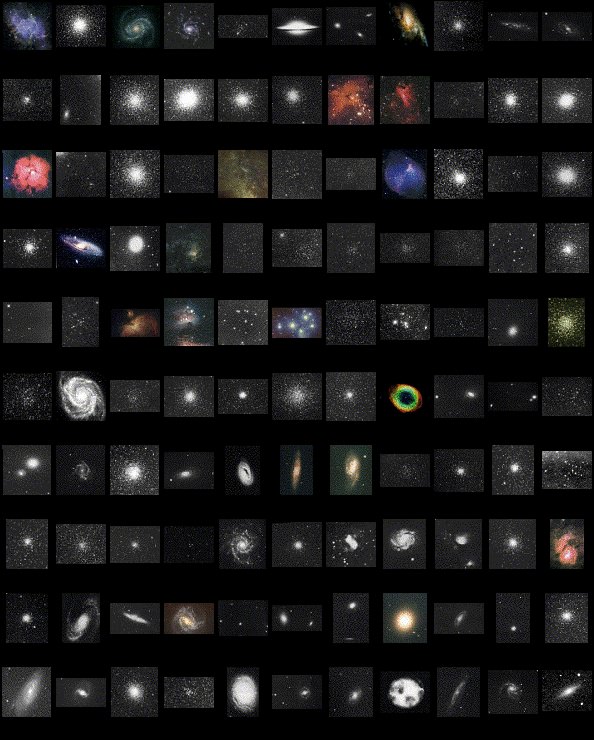[/caption]
If you are new to astronomy, you may ask “what is a Messier Marathon and how do I do one?”
Basically a Messier Marathon is an all night (Dusk til Dawn) observing session held around mid March/ early April every year, where an observer attempts to see all, or as many of the 110 Messier objects as listed by Charles Messier.
The Messier list includes: Nebulae, Galaxies, Star clusters, Supernovae and many other deep sky objects. All of the objects in the Messier list are observable with small amateur telescopes and many of the objects are observable with binoculars.
The reason why Messier marathons take place from mid March to early April is because this is when all of the objects are visible in one evening. Other times of the year aren’t suitable as some of the objects will be in daylight or below the horizon etc.
You don’t have to be an astronomy ace or a seasoned astronomer to do a Messier marathon, but you will need a good telescope to see all of the objects. You don’t even need to do a full Messier marathon as many people do half marathons and depending on your location, or when you observe, you may not be able to see all 110 objects as there is a very tight window of opportunity and higher latitude observers do lose a couple of objects below the horizon.
Timing is key to enable you to see as many of 110 messier objects as possible. Many astronomers put tables and even star charts on the internet to help observers see as many objects as possible.
Observing starts at dusk and ends after dawn and on average each object gets about 5 minutes of observing time before you have to move onto the next one. There can be a short respite half way through the observing session for food and rest, but this depends on the order and success of the objects you are viewing?
Before starting your night of viewing Charles Messier’s wonders, make sure you have all your equipment ready, are dressed warm as it will get cold, have all your charts and viewing tables ready. It also helps to have a hot drink and something nice to eat.
The best dates this year for doing a Messier Marathon have passed and the sky was drenched with the glow of the full moon, but we still have early April. Good luck.
Charles Messier (26 June 1730 – 12 April 1817) was a French astronomer most notable for publishing an astronomical catalogue consisting of deep sky objects such as nebulae and star clusters that came to be known as the 110 “Messier objects”. The purpose of the catalogue was to help astronomical observers, in particular comet hunters such as himself, distinguish between permanent and transient objects in the sky.



Sounds like a great idea. It would certainly make novices better astronomers, familiarizing people with star charts and tables, telescopes, and real-life observation.
No. I live in the southern hemisphere and cannot see all of the objects.
Som people seem to think this is a “badge of honour” or “right of passage” that it makes you an ‘good” or proficient amateur astronomer. It does nothing of the sort.
Take you time, and casually look at them throughout a year, and observe them is style and in care detail. It is better rushing through a whole lot of objects and not properly viewing at them.
Messier Marathons just follow everyone else like a herd of cattle. Not for me, thank you.
Note: M76 is my favourite Messier object. (Perhaps if you want an observational thread, you should ask Tammy (or do it yourself), to have a story on “Your Favourite Messier Object and Why?”
You need to lighten up a tad Crumb. The point of a Messier marathon is to have fun and challenge yourself a bit both in stamina and time management. Not to mention the carnival like atmosphere at a Marathon star party.
I don’t know anyone who considers a Messier Marathon as a “serrious observing session”, quite the contrary actually. They are fun and a great way to experience other telescopes and kids, (at least mine) have short attention spans and like the speed of a marathon.
Come North and give it a try next year. You might enjoy it. 🙂
These events are good fun. You can make of them what you will – serious observing, a serious crack at getting as many objects as possible under your belt, or do what most people do – do it for the social aspect. It’s good to be able to chat with people, check out their scopes, see what objects they’ve bagged or haven’t been able to, have a couple of beers while taking a glance, etc. 90% of amateurs’ observing sessions are generally solo ‘serious’ sessions. It’s a great change to get out for something a bit more social.
Of course, living in Sydney means that a fairly large number of the Messiers are unobservable, but I’ve been able to to do similar events with catalogues such as the Caldwell, and even custom lists formed up by various clubs for the night…
Another Messier Marathon? Be careful now, some might think this has a hidden agenda.
Could be!
It’s been a long time since I have looked at this site and tonight I thought I would check out Tami’s article and I couldn’t believe that the first comment was just like old times, Salacious being his usual cranky self, somethings just never change.
Actually, I’m far from cranky.
The majesty of the heavens a’int no race. If you stop and think and contemplate what your looking at you might just appreciate things just a more. It is just like eating fine food or slowly sipping on a nice red wine.
Why can’t we promote a little more grace in this world other than serving it as disposable quick-fix observing?
In the end it is just my own personal opinion.
Hey guys! The article poses the question “Fancy doing a Messier Marathon this Weekend?” I gave my opinion. Is it my fault that I don’t happen to agree with the question to your satisfaction.
BTW, the following YouTube clip might interest you. http://www.youtube.com/watch?v=10-JnG_M2dcof (Music here is quite appropriate.)
With a paramount and all – that’s doing it in style.
>This video contains content from Sony Music Entertainment, who has blocked it in your country on copyright grounds
Oh. If you want to save a night of your life, look at this YouTube video. You can see all 110 objects in 5min 40 sec! http://www.youtube.com/watch?v=OPXmEsDRP14
(You might want to turn of the music in the background though.)
Sorry Sal, I stand corrected, I should have said you just seem to be cranky, I’m pleased to be wrong. Good link BTW
Crumb, thanks for the links. The second one is from GMARS which is owned by The Riverside Astronomical Society. It is a FANTASTIC site and where I do my dark sky observing. The song is Higher by Creed and needs to be turned UP!! 😀
A marathon is for fun. There are 51 other weekends 12 other new moons for serrious observing. One night of manic observing is a nice change. To each his own.
“The song is Higher by Creed and needs to be turned UP!!”
Fair enough, but it isn’t really my own style. I think that perhaps should have been added as background is some nice classical music from Messier’s era.
What still worries me in this fast paced world is that some sees this as the only form of observing by amateurs. If you have done this just once — well good on you. It is not, however, the pinnacle of observational technique nor the ultimate or grandest challenge. That’s only learn after years of observing.
As for; “To each his own” is sage advise indeed. Wish I said that in the first place! Cheers.